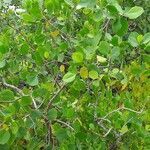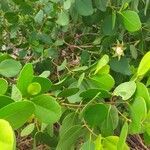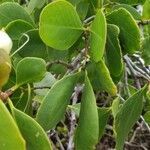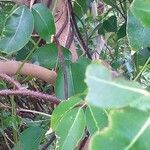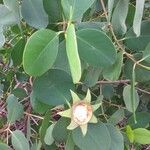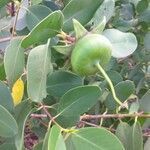An evergreen shrub or usually a small tree, 3–15(–20) m. tall, with many stout finger-like pneumatophores and spreading branches; bark dark grey or greyish-brown, rough and fissured.. Leaf-blades yellow-green, obovate, oval, or almost round, 3.8–12.5 cm. long, 1.7–9 cm. wide, rounded or emarginate at the apex, cuneate at the base; lateral nerves 11–14 on either side of the prominent midrib; petiole stout, 3–15 mm. long.. Flowers scented, solitary or 3 together at apices of the shoots.. Buds oblong, narrowed at base and apex.. Calyx green, 2.6–3.5 cm. long; tube campanulate, angular, the angles alternating with the calyx-lobes; lobes 6–8, magenta-pink inside, green outside, shorter or longer than the tube, 1.2–2 cm. long and 4.5–9(–12) mm. wide, at first more or less erect, later reflexed in fruit.. Petals white or tinged with magenta-pink, soon deciduous, strap-shaped, inconspicuous and closely resembling the filaments, 13–20 mm. long and 0.5–1.25 mm. wide.. Stamens numerous, the filaments showy, white, inflexed in bud.. Ovary 14–18-locular; style green, 4.5–5.9 cm. long; stigma capitate, 2.5–3 mm. wide.. Fruit obconic-turbinate, 2.3–3 cm. long and 3.1–4 cm. wide, green, crowned by the style base.. Ripe seeds not seen.. Fig. 1.
Trees, 3-15(-30) m tall, spreading, with broad, rather lax crown. Pneumatophores 30(-100) cm, thick, blunt. Petiole 5-15 mm; leaf blade adaxially pale, elliptic to ovate or obovate, 5-11 × 4-8 cm, base rounded, apex broad, rounded, with broad recurved mucro. Flowers 5-8-merous. Floral tube shiny, 3-3.5 cm at anthesis, smooth, often 6-ribbed; sepals adaxially strongly tinged red, 1.3-2 cm, ± erect at anthesis, recurved in fruit. Petals white, linear, 1.3-2 cm × ca. 1 mm, or variably semipetalous to absent. Staminal filaments white. Fruit 2-4.5 cm in diam., ca. equal to width of floral tube. Seeds falcate. Fl. common Oct-Nov, fr. ca. Feb. 2n = 22, 24.
Tree 3–20 m high. Leaves: lamina obovate, ovate or orbicular, 5–11 cm long, rounded with broad tip reflexed; petiole 5–15 mm long. Inflorescence 1–5-flowered. Flowers usually 5–8-merous. Sepals ovate-triangular, 1.5–2 cm long, ±erect in flower, recurved in fruit, green and smooth outside, often red inside. Hypanthium cup-shaped, sometimes ribbed. Petals present or absent, linear, 1.5–3 cm long, 0.5–2 mm wide, mostly white. Stamens 1.5–4.5 cm long; filaments white. Ovary half-inferior with 12–20 carpels; style 2.5–4.5 cm long. Fruit 2–4.5 cm diam., c. equal to hypanthium width; hypanthium cup-shaped, 1.5–2 cm high. Seeds sickle-shaped.
A large tree. It grows 26-40 m high. The trunk can be 70-175 cm across. The bark is dark grey. The trunk is swollen at the base and with aerial roots. The leaves are thick and leathery, rounded at the tip and 6 to 12 cm long by 3-9 cm wide. They are nearly as wide as long. The outer ring of sepals is green and leathery. The petals are white and narrow and fall off early. The fruit are hard, rounded and pushed down at the tip. They are 3 to 4 cm across and contain many seeds.
Leaf-lamina 3–12.5 × 1.7–9 cm., obovate-circular to broadly obovate-elliptic or sometimes elliptic, rounded or emarginate at the apex, cuneate at the base, somewhat waved at the margin, coriaceous, yellow-green; midrib impressed above, prominent beneath, with 11–14 pairs of lateral nerves; petiole stout, 3–15 mm. long.
Calyx-tube c. 1.5 cm. long, thick, campanulate, angular, the angles alternating with the 6–8 lobes; lobes reddish inside, green outside, 12–20 × 6–9 mm., lanceolate, erect in the flower, ± reflexed in fruit.
Old branches covered with a dark-grey or greyish-brown rough and fissured bark, the young ones terete, swollen at the nodes.
An evergreen mangrove shrub or tree, 3–15 m. tall, with spreading branches and many thick finger-like pneumatophores.
Stamens 8, the filaments up to 3.5 cm. long, inflexed in bud; anthers c. 1.5 mm. long.
Petals 13–20 × 0.5–1.25 mm., ligulate, white or dorsally tinged with pink, caducous.
Fruit c. 3.8 cm. in diam., surrounded at the base by the persistent calyx.
Flowers odoriferous, rather large, 1–3 together, terminal.
Ovary 14–18-locular; style 4.5–6.5 cm. long.
Bud ellipsoid, c. 3 × 2 cm.
